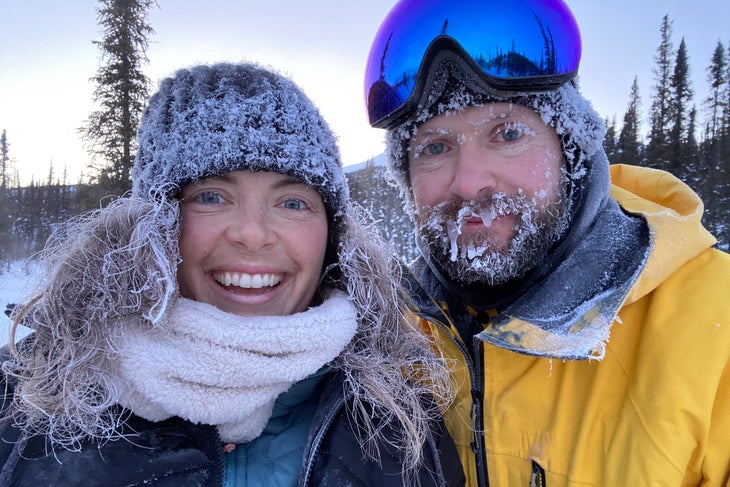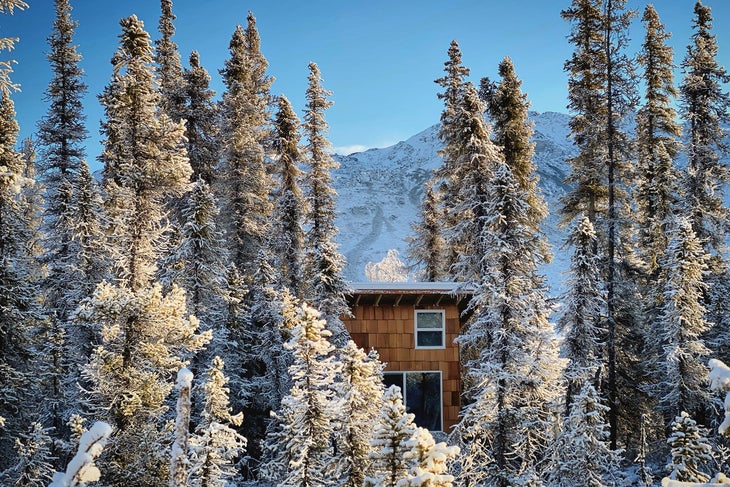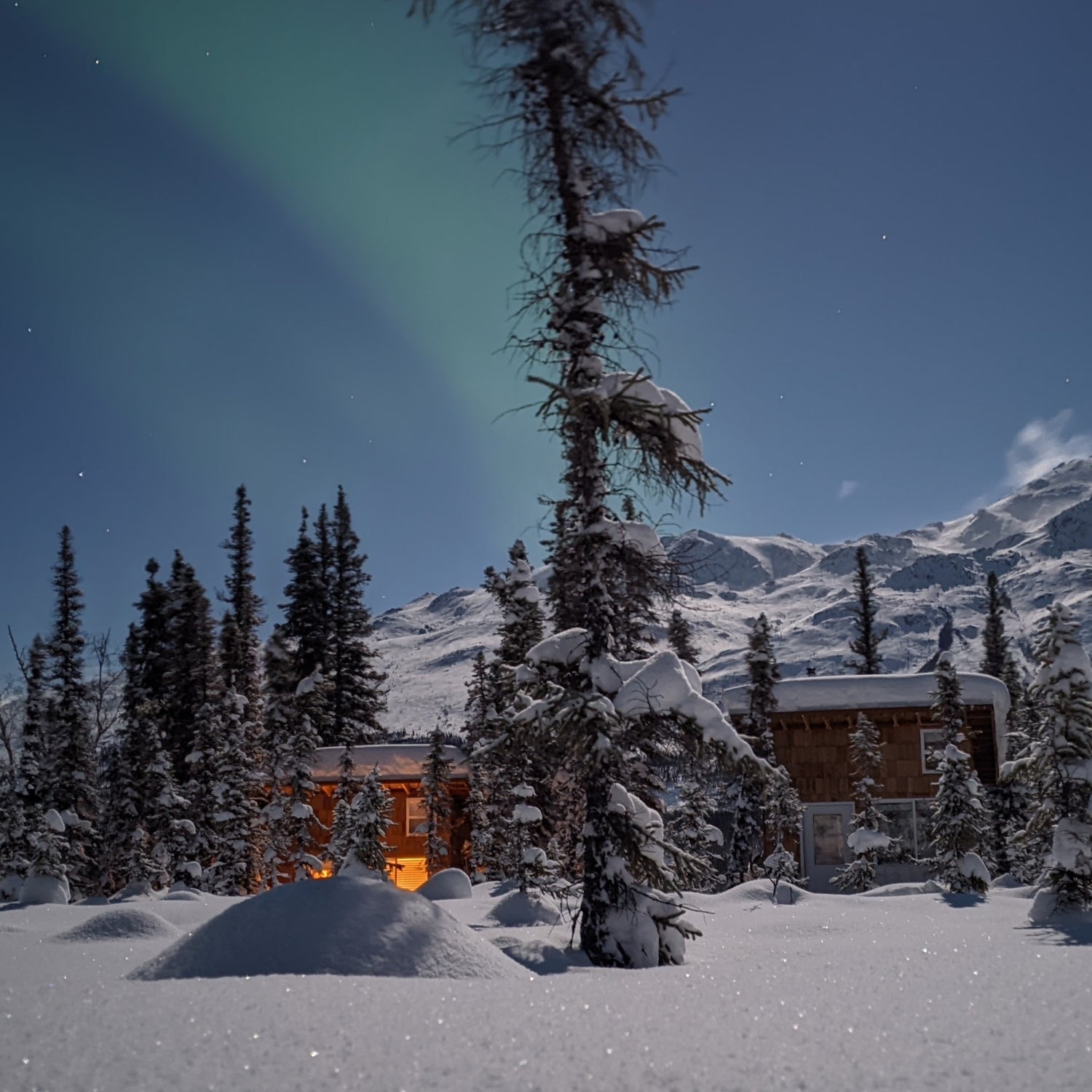About eight years ago, I stepped through the unlocked door of a 1915 cabin-turned-chapel in Wiseman, Alaska, an Arctic settlement of about a dozen people roughly seven hours north of Fairbanks. In the dim light, the pastor’s log was open on the makeshift pulpit for anyone to read, and I quickly lost myself in pages of lilting cursive.
It was September, the Arctic tundra glowed with electric reds and rusts, and every day the snow line crept down the stone pyramids of the Brooks Range. The pastor, who had lived in Wiseman for decades, described the inexorable march of darkness as a force both terrifying and beautiful. She spoke of chopping wood, preserving berries, and squeezing the joy out of every moment of daylight before a winter in which, for more than a month, the sun never rises above the horizon.
The notion of such sustained darkness in a remote corner of the planet unnerved me. Residents of the Arctic tell stories of people losing their minds in the black of polar night. But I also felt strangely curious—and drawn to return one day.
For years, I tried to manufacture a good excuse to travel to the great north in the depths of winter, but it never worked out. It’s not exactly easy to get to at any time of year and services like hotels and transport are few. (During my previous trip, I had been on my way to report on polar bears farther north.) But last summer, a friend forwarded me an email about a tiny off-grid six-person retreat center that had just opened outside of Wiseman. The owners were hosting a week-long trip that included yoga and exploring the Arctic wild with skis, snowshoes, and dogsleds, and the dates fell right on the winter solstice.
I couldn’t resist signing up for the retreat, but I had hesitations. I’m not exactly a cold-resistant creature: I’ve suffered from hypothermia multiple times and frostbite that turned my feet white and wooden. I’m generally dressed in a sweater and jeans when my friends are wearing shorts and flip flops. Even at much more temperate latitudes, seasonal affective disorder runs in my family. I also contemplated the wisdom of traveling during a pandemic, and the carbon emissions of flying long distances. If rationality won, I wouldn’t have gone. And yet, some powerful urge that I can’t quite explain compelled me to commit. Perhaps it was the pull of long-gestating curiosity or some gut-level instinct, but that’s how I found myself on a plane to Fairbanks on one of the darkest, coldest days of December.
When I arrived in the central Alaskan city, it was early afternoon, the sun already grazed the horizon, and the temperature was 37 degrees below zero. In cold that deep, snow stays fluffy, and everything sparkles as if scrubbed. Even the air itself seems pristine. Soon after arriving, I tugged my snowpants over my jeans, donned both my down jacket and an insulated parka, and pulled on my warmest hat for a short walk. The cold blew through it all in seconds. My eyelashes froze and my nose hairs crinkled. The liquid on my eyeballs felt like it was turning to slush. Even the slightest breeze lacerated my cheeks, and my mind felt tight with a barely concealed panic. I grew up in Boston, and I was still shocked by the cold’s staggering punch. I had never felt anything like it, and the next day I’d be traveling seven hours north by car.
The area around Wiseman, Alaska, has been traveled for thousands of years by groups including the Gwich’in, Koyukon, and Inupiat. It’s a spare and beautiful land of shocking extremes—not exactly a practical spot to build a retreat center, even a small one. Mollie and Sean Busby, the founders of , know this intimately. The couple—a 36-year-old yoga instructor and a 38-year-old pro snowboarder—have spent the last few years negotiating the rigors and hazards of the Arctic and developing friendships in the community, a necessity in a place where people are few and the margins of survival have sharp edges. Their property lies beyond the reach of roads, on a limestone bench on a mountainside a one-mile hike or snowmachine ride from the end of the road in Wiseman. In the winter, they fetch water from a chipped-out hole in the Koyukuk River and heat their cabins and two communal domes with wood-burning and Swedish oil stoves, sometimes both at the same time. Nine sled dogs live in trim dog houses in the middle of their compound and yip and howl with glee when humans approach. Sometimes the wolf packs that haunt the area howl back. About an hour north, the continent’s forests peter out into tundra that stretches straight to the Arctic Sea.

Mercifully, the temperature actually rose as Mollie drove four of us north on the Dalton Highway in a Suburban loaded to the ceiling with supplies, groceries and dog food. The winds screamed across the road, obscuring it with skeins of shifting snow, but Mollie, a hardy down-to-earth Wisconsinite, seemed unfazed. “It’s worse in summer,” she said casually, fiddling with the radio dial. “Cars catch air off the frost heaves.”
As we wound farther north, the sky brightened without even a trace of hurry, and the boreal forests appeared in foggy grayscale. The three other participants, a wilderness therapist from Vermont, an emotional-intelligence educator from Massachusetts and a biological anthropologist from Texas, all of us women in our thirties and forties, simmered into a reverent silence. There aren’t a lot of signs of human beings between Fairbanks and Wiseman except two lonely truck stops and glimpses of the Alaska Pipeline, for which the road was originally constructed. But natural wonders abound, from a solitary moose or caribou ambling the highway to eerie tracts of snow ghosts, stunted black spruce trees encased in rime ice that appear figure-like, as if monks in prayer.
A week before we arrived, the Busbys dug themselves out of nearly four feet of snow, the area’s deepest 24-hour snowfall in half a century. It took days for them to create enough friction to heat the bottomless fluff so that it would pack down into trails. After arriving at the end of the road (in the dark, of course) we pulled on our cold-weather gear and headlamps and hiked to Arctic Hive’s encampment. When we arrived, string lights hung between the trees, illuminating everything in a surreal, romantic glow. Footpaths formed miniature slot canyons made of snow. The dogs’ joyful howls rung through the forest. Perhaps it was the muffle of snowy darkness or the cold or the sheer remove from daily life, but it felt like we had passed through a gate into a different plane.
Between November 30 and January 9, the residents of Wiseman, Alaska, do not see the sun. They lose about 12 to 15 minutes of light each day until the solstice and then gain it back just as quickly. The future always looks scarier from the confines of imagination, and polar night was not so unnerving once I was in it. It was actually brighter than I anticipated—locals like to say that on the winter solstice, there are still five hours when it’s light enough that you can’t see the stars.

Perhaps by the grace of my own temporariness, the darkness felt benevolent. Over the course of a week, long slow dawns bled into long luxuriant dusks. Storm clouds lingered for days, swaddling the land in a moody dimness that made the forests and tundra appear soft-focus like a dream. Clock time began to feel less relevant without the familiar reference points of day. In my blond-wood cabin, with the Swedish oil stove murmuring, I slept like a teenager, waking only briefly and folding myself back into the embrace of night.
But the land and conditions also continually reminded us of their wildness and indifference. I marveled at how quickly my feet traced the edge of dangerous numbness; there isn’t much room for miscalculation. One day, in the precious hours of gloaming, we hiked up a nearby river canyon on snowshoes, sinking into knee-deep powder, tromping over minty blue glacial ice and clambering up frozen waterfalls. At times, flowing water thundered under the ice, spooking us all. The wind raged down the canyon’s hallways, stacked with a million delicate layers of limestone, only to relent into stillness around a bend. Later, we discovered that a local subsistence hunter had just trapped an enormous wolverine not far from where we turned around.
The area’s waterways have mercurial rhythms and sometimes river water escapes and flows over the ice, creating a layer of overflow topped by newly formed panes. “OK, I’m just going to commit,” Sean said one day as we stood in our snowshoes, feeling unnerved as we contemplated the loose floating shards. (Luckily, we only sank in about six inches.)
The intensity of the cold itself makes for unique considerations. Touching anything metal, even a zipper, feels like it burns, and frozen supplies and equipment can easily shatter. “One time we had the vacuum outside,” Mollie says. “I felt like I just looked at it and all of the sudden one of the hoses broke.” Simply to run a mile to their truck, the Busbys carry an emergency beacon if they’re alone. And living in polar night, residents of the Arctic have to be especially attentive to the risks of cabin fever. Some locals take copious doses of vitamin D. “And no matter what the temperature is,” Sean says, “you have to get outside everyday.”
It’s hard to imagine anyone would move to or stay in such an extreme place without some heartfelt need or purpose. Sean has always found solace in the mountains but even more so after his older brother died suddenly from a brown recluse spider bite when Sean was 16. After snowboard expeditions to all seven continents, for whatever reason, he and Mollie felt most deeply drawn to the high north. Looking at maps, they found Wiseman at an appealing latitude with the gift of skiable mountains. Sean also has several autoimmune disorders, including a photosensitive form of lupus that, in Montana, where the couple previously lived, discouraged him from going outside when the sun was shining. In the Arctic, even in summer, the UV light is low. “This is my happy place,” he told me. “To see people’s reaction to the environment up here is just the best feeling. You see that they get what you get. Something clicks. Something becomes tangible. I would say that a lot of our focus has been trying to create something tangible that people can then bring home with them to be better advocates of our natural spaces.”
Being off-grid, Arctic Hive is not fancy—I didn’t take a shower for a week and sat upon the iciest outhouse seat of my life. But in contrast to the merciless conditions, the snug indoor spaces felt decadent. Being physically comfortable allowed me to absorb the singular beauty of the place in ways I may not have otherwise. And luckily, the schedule was casual. We went dogsledding in the twilight beneath gigantic peaks and cross-country skied through forests so silent that when I stopped, all I could hear was the sound of my own heartbeat. With harnesses, we hooked up the sled dogs and went skijoring through the crystalline black, dodging willows and ducking under spruce boughs. We crossed fresh lynx tracks twice. In the mornings, Mollie led us in long, leisurely sessions of yoga in the cozy dome with both stoves firing. ���ϳԹ��� the window panes, the silhouettes of the trees emerged from the navy cover of night slowly, almost imperceptibly, over hours.
Mollie told me one evening that people often ask her and Sean what they miss about life in a more moderate clime, and she chuckles at the assumption of lack. “This was a choice,” she says. “I don’t miss anything.”
On the winter solstice, the Alaskan Arctic is a place of potent liminality. It felt like the edge of the world. I gravitated to being alone, dawdling on our hikes back to the Hive, soaking in the strange rhythms of light and dark and gazing up at the sky’s ever-shifting morphology of blues. In the middle of the night, I watched as the moon traveled unfamiliar trajectories across the sky, and in the sumptuous warmth of the yoga dome one evening, after everyone else had left, in the gleam of a dozen flickering candles, I sat and listened to the wind for hours. More than I can ever remember, I felt a simple but unmistakable sense of belonging that I am rarely still enough to discern. Since I returned, when the walls of daily life feel like they’re closing in, remembering that sense of connection to this vast, wild planet has been a salve, a source of perspective, and a motivator.
Naturally, I wasn’t blind to the way a place this remote is affected by the environmental crises we all face, crises that often weigh on my mind and inform many, if not most, of the decisions I make. In some ways, the effects of climate change are even more extreme in the Arctic. While I was there, the temperature shot up to an almost unheard-of 28 degrees and then boomeranged 65 degrees back down in 24 hours. One local, Jack Reakoff, who has lived here since the seventies, told us stories of bizarre weather events that caused mass die-offs of moose and dall sheep in the last few years. I felt the grief of these unignorable truths. But it also felt like mourning or despairing were incomplete ways of relating to a place this spectacular.
One night, I wandered out of my cabin, wrapped in a sleeping bag I had brought just in case, and watched slack-jawed as the northern lights whirled across the dome overhead like a luminous river. After many days, the formidable peaks of the Brooks Range finally disrobed from their mantle of clouds and shone resplendent in the moonlight. Standing all alone in the snow, I felt like I had landed in a forgotten kingdom. It occurred to me that none of us can ever truly live up to the gift of simply existing on a planet of such outrageous magnificence. Maybe the celebration is every bit as necessary as the grief.


